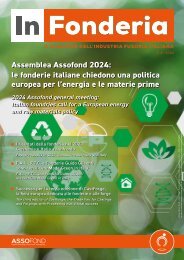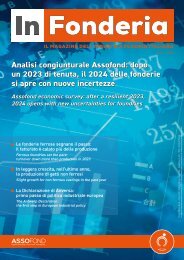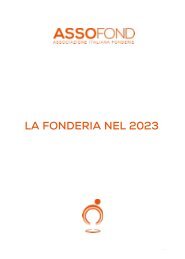In Fonderia 2 2024
Secondo numero del 2024 di In Fonderia
Secondo numero del 2024 di In Fonderia
Create successful ePaper yourself
Turn your PDF publications into a flip-book with our unique Google optimized e-Paper software.
ARTE E FONDERIA<br />
Gian Battista Forchino ed Emilio Sperati. Il varo della nave, Bronzo Collezione<br />
Sperati, Consiglio Regionale del Piemonte, Palazzo Lascaris, Torino.<br />
Gian Battista Forchino and Emilio Sperati. Launch of a Ship, Bronze, Sperati<br />
Collection, Piedmont Regional Council, Palazzo Lascaris, Turin.<br />
scolari. Quadri e bronzetti si inseriscono perfettamente<br />
in tale clima culturale, caratterizzato in<br />
campo artistico dalla crescita del mercato e da<br />
una maggiore richiesta di opere d’arte da parte<br />
di una fiorente borghesia; in particolare, i bronzetti<br />
spesso “multipli” di opere d’artisti famosi, si<br />
presentano di dimensioni adatte ad appartamenti<br />
di città, di prezzo abbordabile e di grande<br />
arredo.<br />
Molti di questi bronzetti sono andati dispersi sul<br />
mercato antiquario dove, a tutt’oggi, sono assai<br />
ricercati. Il nucleo principale è però fortunatamente<br />
approdato nella storica sede del Consiglio<br />
regionale del Piemonte: Palazzo Lascaris a<br />
Torino. Nel 1980 con generosa munificenza Luisa<br />
Sperati, figlia di Emilio, ha infatti donato alla Regione<br />
Piemonte tutte le opere d’arte che aveva<br />
ereditato dal padre: 85 fra quadri e miniature,<br />
100 bronzi, 45 oggetti in porcellana e terracotta.<br />
La raccolta di bronzetti è composta per la<br />
maggior parte da opere di artisti che Sperati<br />
conobbe direttamente e di cui divenne amico,<br />
frequentando l’accademia a Brera nel decennio<br />
1870-80.<br />
<strong>In</strong> rapida sequenza, segnaliamo tra le opere<br />
maggiori, la Slitta di Paolo Troubetzkoy plasmata<br />
con sensibile gusto pittorico, piena di vitalità e in<br />
grado di trasportare magicamente l’osservatostatue<br />
of the Tsar was destroyed. Despite the difficulties,<br />
in 1906 Sperati managed to open a new<br />
workshop and to cast the ill-fated statue, which<br />
had gone through a series of complex events,<br />
first placed in Znamenskaya Square. It was then<br />
removed and ended up in the warehouses of the<br />
Russian Museum (the Marble Palace of St. Petersburg),<br />
from which it was removed in 1953<br />
to be then placed in the courtyard of the same<br />
building where it is still located today .<br />
The cast earned him much praise and the Order<br />
of St. Anna, awarded to him by the tsar. When<br />
the political conditions in Russia became dangerous,<br />
Sperati decided to return to Italy. Worn out<br />
by those experiences, he retired to Turin where<br />
he stopped producing large-scale castings, dedicating<br />
himself only to the creation of exquisite<br />
bronzes, to painting, and to collecting the works<br />
of his painter friends. He died, almost forgotten,<br />
on 30 August 1931.<br />
A man of notable artistic culture, Sperati was,<br />
therefore, also a refined collector.<br />
His collection, in line with the personal history<br />
and events of the man who built it, perfectly expresses<br />
the ephemeral time of the Belle époque,<br />
between 1880 and 1915. The painters and sculptors<br />
who are part of the collection with dates between<br />
the 1880s and the 1920s are all romantic<br />
or crepuscular. Paintings and bronzes fit perfectly<br />
into this cultural climate, characterised in the<br />
artistic field by market growth and a greater demand<br />
for works of art by a thriving bourgeoisie;<br />
in particular, the often “multiple” bronzes of works<br />
by famous artists are of a size suitable for city<br />
apartments, of great furnishings and affordable<br />
in price.<br />
Many of these bronzes were dispersed in the antiques<br />
market where they are highly sought after<br />
to this day. However, the main nucleus has fortunately<br />
ended up in the historic headquarters of<br />
the Piedmont Regional Council: Palazzo Lascaris<br />
in Turin. <strong>In</strong> 1980, Luisa Sperati, Emilio’s daughter,<br />
generously donated to the Piedmont Region all<br />
the works of art she had inherited from her father:<br />
85 paintings and miniatures, 100 bronzes,<br />
45 porcelain and terracotta objects.<br />
The collection of bronzes is composed mostly of<br />
works by artists that Sperati knew directly and<br />
became friends with, attending the academy in<br />
Brera in the 1870-80s.<br />
<strong>In</strong> rapid sequence, notable among the major<br />
works is Paolo Troubetzkoy’s Sleigh, shaped with<br />
sensitive pictorial taste, full of vitality and capa-<br />
104 <strong>In</strong> <strong>Fonderia</strong>














